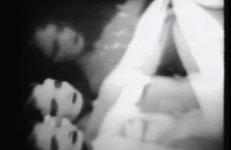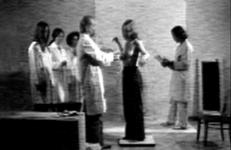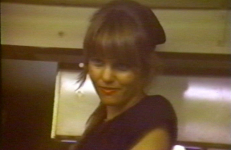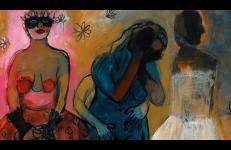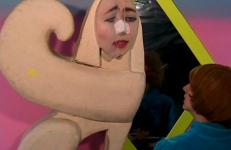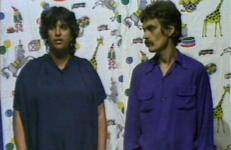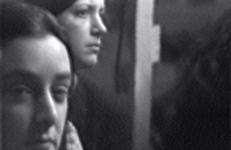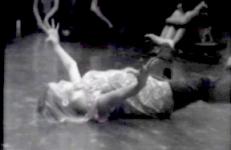In this well-known early tape, Jonas manipulates the grammar of the camera to create the sense of a grossly disturbed physical space. The space functions as a metaphor for the unstable identity of the costumed and masked female figure roaming the screen, negotiating the rolling barrier of the screen’s bottom edge.
Feminism
A cross-generational binding of three filmmakers seeking alternative possibilities to the power structures they are inherently part of. Each woman extends her reach to a subject she is outside of. Vever grew out of the abandoned film projects of Maya Deren and Barbara Hammer. Shot at the furthest point of a motorcycle trip Hammer took to Guatemala in 1975, and laced through with Deren’s reflections of failure, encounter and initiation in 1950s Haiti.
A vever is a symbolic drawing used in Haitian Voodoo to invoke Loa, or god.
Taking aim at the social standardization enforced particularly on women's bodies, Rosler critiques the politics of "objective" or scientific evaluation that result in the depersonalization, objectification, and colonization of women and Others. As Joseph Di Mattia has pointed out, "The title of the tape is ironic--just exactly to whom are these 'statistics' 'vital'?
A multiple award winner, this experimental tape explores the psychological ramifications of a woman growing up under orthodox Islamic law. Resisting traditional definitions of a woman’s role in society as first and foremost a dutiful daughter or wife, Nanji struggles to find a space amidst the web of restrictive familial and societal conventions.
This performance video offers a humorous critique of Hollywood power relations. Mogul masquerades as a stereotypical male film director auditioning would-be starlets at a soda fountain--a parody of the rags-to-riches legend of Lana Turner's "discovery" at Schwab's drugstore. In over-the-top performances that poke fun at traditional female passivity, feminist artists including Arlene Raven, Cheri Gaulke and Nancy Angelo, enact the roles of pliant actresses-in-waiting who submit to the whims and sexist jabs of a dictatorial director.
We Were Hardly More Than Children tells an epic tale of an illegal abortion, as lived by two women on a perilous journey through a world that has little concern for their survival.
Paintings by Diane Messinger.
Music by Renato Umali.
Lena and friend: Flora Coker and Cecelia Condit.
An experimental video for electro-feminist-performance-artists Le Tigre, the early eighties MTV aesthetic unpacks a thoroughly current obsession: the hidden erotics of office supplies.
This title is also available on Elisabeth Subrin Videoworks.
Strapped for time due to her busy schedule of personal appearances, Anderson creates a rather clumsy looking clone to take over and keep up her artistic production. Anderson plays both parts, pitting the chain-smoking, productive male half against the laid-back female half. In the end, one highly successful clone begets another clone, a situation spoofing the rise and fall of the '80s art star.
In today’s youth-oriented society, the experience and knowledge of older women is typically unheralded and neglected. Countering these ideas is Suzanne Lacy’s Whisper, The Waves, The Wind—a performance evoking and reinforcing the strong spiritual and physical beauty of older women. Lacy says, “They reminded me of the place where the ocean meets shoreline. Their bodies were growing older, wrinkled. But what I saw was the rock in them; solid, with the presence of the years washing over them.” This tape is a document of that performance.
In this episode of the Whispering Pines series, Moulton's character Cynthia is confronted with a distorted mirror image that slips between the grotesque and the exotic, depending on her posture.
Linda Williams writes on what she calls “body genres”: melodrama, horror, and, most famously, pornography. One of the most influential feminist film scholars to emerge in the 1980s, she wrote important essays on the women’s film (melodrama) before publishing her most influential work, Hard Core: Power, Pleasure, and the Frenzy of the Visible (1989 and 1999).
Feminist performance artist, Martha Wilson (b.1947), is director and founder of the alternative New York art space, Franklin Furnace Gallery, in operation since 1976. In this interview, Wilson discusses her Quaker upbringing, the impetus for her move from Nova Scotia to New York, and the founding of Franklin Furnace, as well as her involvement in the feminist punk band collective Disband.
Woman as Protagonist: The Art of Nancy Spero is an invigorating look at the 40-year career of acclaimed feminist artist Nancy Spero, who, in her own works, is concerned with “rewriting the imaging of women through historical time.” With Spero’s own voice as narration, this documentary tracks her development as she matured against the grain of Abstract Expressionism, Minimalism, and Pop Art when “there wasn’t room in the art world to make way for political or activist art.” This tape includes footage of the artist at work on installations in the United States, Northern Ireland, and
In creating this record of her pregnancy, the changes and special insight it brings, Millner borrows freely from anthropology, art history, soap operas, physical fitness scams, sex education manuals, and psychoanalysis. Through the Sunrise Of Conception and the Pillar Of Saltines, combatting morning sickness all the way to the big finish, Womb With A View details one woman’s odyssey into motherhood.
Ten thousand women marched down New York's Fifth Avenue on August 26th, 1970, to mark the fiftieth anniversary of the passage of the 19th amendment, which granted women the right to vote. The march was part of a "Women's Strike for Equality" organized by veteran feminist leader Betty Friedan.
This video, shot in March 1970, contains raw footage from a Women’s Liberation event and discussion that took place in an art space. The tape begins with shots of the crowd mingling while music and speeches are heard in the background. Speakers address the audience, and the tape continues to record the discussion that follows. The main topics are abortion and contraception, and how they relate to power dynamics and the struggle for Women’s Liberation in general.
This video consists of raw footage from a Women’s Liberation Rally in New York City, shot on March 7th 1970, in celebration of International Women's Day. The first two thirds of the piece consist of footage of the crowd and speakers. Many issues are discussed including medical care, childcare, racial solidarity, Puerto Rican liberation, and imperialism. The final third of the tape includes interviews with male and female attendees of the rally.
In Barbier’s meditative journey through India, she deconstructs the myth of the objective documentary by using textual commentary and off-camera remarks to address the problematic relationship of observer to observed. Framing the images through the artist’s subjective and distinctly female point of view, she explores images of women working, sweeping, cooking, and tending children in direct juxtaposition to men who sit, relax, and observe the spectacle.
This tape, shot at the YMCA in Rochester, New York on July 18th, 1971, preserves the informal and communal atmosphere of an event known as the Women’s Conference. The participants, predominantly young white women, appearing to be in their early twenties, spent several hours together gleefully singing, acting, and dancing as an expression of their dedication to women’s civil rights. In various theatrical performances, the participants touch upon subjects such as police violence, racism, freedom, and women’s rights.
You Were an Amazement on the Day You Were Born is a visually stunning work that follows a woman through a life characterized by damage and loss, but in which she finds humor, love, and joy. With a score that follows the span of Lenore’s life, from her birth in the early 70s to her death in the 2040s, the film takes us from moments of harrowing loss to those of poignancy and dark humor.
You Were an Amazement on the Day You Were Born is a visually stunning work that follows a woman through a life characterized by damage and loss, but in which she finds humor, love, and joy. With a score that follows the span of Lenore’s life, from her birth in the early 70s to her death in the 2040s, the film takes us from moments of harrowing loss to those of poignancy and dark humor.




